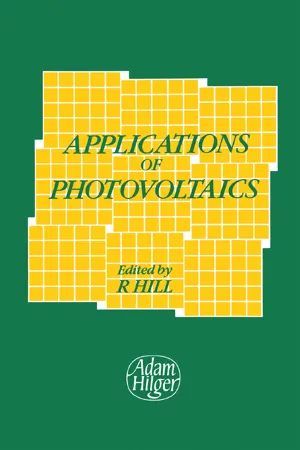1.1 Introduction
The photovoltaic effect, the direct conversion of light energy into electricity by solar cells, was first observed in 1839, but until the mid-1950’s it remained largely a laboratory curiosity with relatively few practical uses. Some work was carried out by various laboratories to see if practical devices could be developed for battery charging, but the real breakthrough came with the space programme, starting with America’s Vanguard I in 1958. Since then, practically all the many hundreds of scientific, commercial and military satellites launched by the various space organisations have been powered by silicon photovoltaic cells.
Following the 1973 oil crisis, interest in photovoltaics as a terrestrial source of power increased greatly and many countries, including several developing countries, instituted photovoltaic research, development and demonstration programmes. For example, in addition to the investments made by the manufacturers and other private interests, the US government increased its annual photovoltaic R & D budget from about $1 million in 1974 to more than $100 million per annum in the late 1970’s and, despite recent cut-backs, still exceeds $30 million per annum. Although the level of funding has been somewhat less in Japan and in the European Community, there have been similar co-ordinated programmes of photovoltaic research and development. Total world expenditure from all sources on photovoltaic research, development and demonstration activities is currently (end 1987) estimated to be running at between $200 and $300 million per annum.
Photovoltaic arrays for space satellites are assembled to very exacting standards, as low weight and high reliability are of the utmost importance. Costs are consequently very high, with each Watt of power costing several hundred US dollars, but it has to be recognised that the total solar array cost for a satellite is relatively small in relation to the total project cost. The key issues for satellites are the power-to-weight ratio and reliability, not costs.
Much less expensive photovoltaic systems have been developed for terrestrial applications, where the environmental and other constraints are not nearly so onerous as in space. Over the last ten years, there has been more than a tenfold reduction in the real price of photovoltaic modules. This has been achieved through a combination of improved cell technologies and larger manufacturing volumes. Starting from virtually zero in 1974, sales of photovoltaic systems have grown to about 32 MWp in 1987, with a total value of at least $500 million. Worldwide there are over 20 module manufacturers of significance and there are several times this number of firms designing and marketing photovoltaic systems using bought-in components.
Costs have been steadily falling in real terms to the point where photovoltaic systems are now becoming competitive with other means of providing electrical power for an ever-widening range of applications, from small calculators and battery chargers, through navigation lights, water pumps and cathodic protection systems, to generators for remote buildings and island communities. New applications are being found for which other forms of electricity generation are quite unsuitable. There are good prospects for further cost reductions, which will open up applications for photovoltaics where the markets are very large indeed, such as rural electrification and even, in time, grid generation.
1.2 Photovoltaic Systems
1.2.1 Market Categories
Photovoltaic systems provide a convenient and cost-effective solution for the provision of relatively small amounts of power needed for a wide range of applications. Needing no fuel and very little maintenance and with no harmful pollution at the place of use, such systems offer many attractive features in comparison with the possible alternatives. In some cases, photovoltaic systems provide the only acceptable method of providing the necessary electrical power at a remote site.
At present there are three market categories for photovoltaic systems. First there is the large and growing consumer market, for small electronic devices, garden lights dry-cell battery chargers, and such items. Sales in this market are largely dependent on good design, effective marketing and reasonable prices. Secondly, there is the market for professional systems, such as telecommunication links, remote sensing, cathodic protection, navigation lights, military equipment, etc. These systems normally have to be justified on the basis of life-cycle costings using conventional economic criteria, although environmental considerations can often be an important factor. Thirdly, there is the very large potential market for systems which primarily have a social benefit, such as the provision of electricity for remote houses and villages, pumps for water supplies and irrigation, emergency telephone links, etc. Although these systems are expensive ($12–20 for every Watt of installed array power), the photovoltaic solution can provide important social benefits to a needy community, with lower life-cycle costs (and far lower operational problems) than diesel generators or grid-extension.
In the longer term, as system costs continue to fall in real terms, a fourth market catego...
